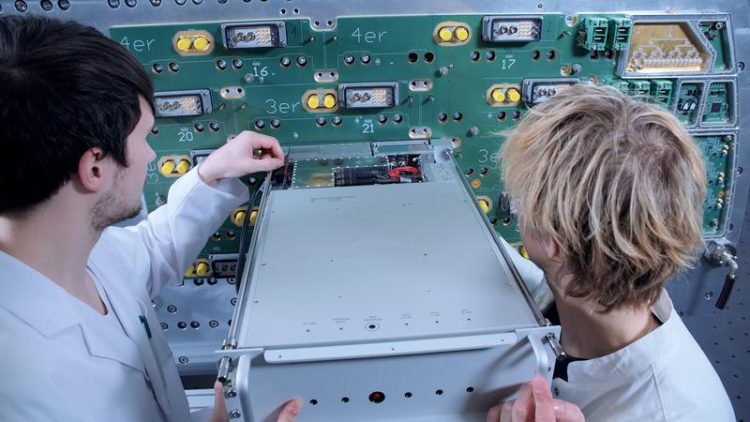GESTRA – New space surveillance capabilities in Germany

Complex, leading-edge technology in GESTRA: 40 subsystems on 8 enormous circuit boards (130 cm x 55 cm) are mounted directly on the aluminum antenna plate with cooling circuit. Fraunhofer FHR
Due to its many years of experience in the area of space observation with radar, Fraunhofer Institute for High Frequency Physics and Radar Techniques FHR is a renowned expert in this field. With its radar system TIRA, the institute offers capabilities that are not available anywhere else in the world.
At the beginning of April, Fraunhofer FHR provided the last images of the Chinese space station Tiangong-1. These images went around the world. The scientists are, however, working hard to extend these capabilities. With the new radar system GESTRA (German Experimental Space Surveillance and Tracking Radar), round-the-clock observation of active satellites and space debris will be possible for the first time in Germany. This will pave the way for the creation of an orbital data catalog which will be instrumental in preventing collisions.
Radar warns of space debris
The “traffic situation” in space is very tense: the Earth is currently being orbited not only by countless satellites but also by a large volume of space debris resulting, for example, from burned-out rocket stages and fragments of exploded space objects. These are gradually transforming the orbit into a junkyard. Approximately 20,000 objects with a minimum diameter of ten centimeters are presently orbiting the Earth at an average speed of 25,000 kilometers per hour. Added to this are 700,000 smaller objects with a diameter greater than one centimeter. Due to their enormous speed, these small debris particles can also damage or destroy active satellites.
Collisions between space debris and satellites can be prevented by means of evasive maneuvers. Maneuvers of this kind are, however, time consuming and tie up valuable resources and are therefore only required by operators when the satellite is in real danger. Comprehensive cataloging of the space objects and high-precision orbit determination of the potential collision objects are essential to assess this risk. Radar systems can carry out both of these tasks.
GESTRA: Wide-range space surveillance with leading-edge technology
Seamless and continuous space surveillance can only be achieved with phased array radars. The electronically controlled array antennas are capable of conducting large-scale space surveillance in near-Earth space around the clock. The new space surveillance radar GESTRA, which is currently being developed by Fraunhofer FHR for the Space Administration of the German Aerospace Center (DLR), is equipped with an electronically steerable antenna which is able to scan large areas of the sky within milliseconds due to the integration of the latest semiconductor technology.
The sensor consists of a transmit and receive module, each of which is integrated into an 18 m x 4 m x 4 m shelter. Due to its compact design, GESTRA is a mobile system which can be transported to any required location.
When put into operation for the German Space Situational Awareness Center of the German Armed Forces in 2019, wide-range surveillance of the debris population in near-Earth space (orbital heights of 300 km to 3,000 km) will be possible from German territory for the first time. GESTRA will then operate continuously to create a catalog of the debris in near-Earth space. This new data basis will have a great influence on the further development and operation of the space infrastructure of Germany and Europe.
Learn more about the new GESTRA system
On Monday 23.04.2018 at 10 a.m., Fraunhofer FHR will present the space surveillance radar GESTRA and its innovative and complex techniques in a film which can be viewed at www.fhr.fraunhofer.de/gestra.
Visit us at the ILA Berlin from 25-29 April 2018. Information on GESTRA will be available at three exhibition stands: Hall 4, Stand 202 (Fraunhofer-Gesellschaft), Hall 3, Stand 302 (German Space Situational Awareness Center of the German Armed Forces) and Hall 2, Stand 203 (Federal Ministry of Economic Affairs and Energy).
https://www.fhr.fraunhofer.de/en/press-media/press-releases/gestra-new-space-sur… Printable images and the press release
GESTRA-Filmteaser: https://www.youtube.com/watch?v=4MdmSxXcJ4M
Media Contact
All latest news from the category: Physics and Astronomy
This area deals with the fundamental laws and building blocks of nature and how they interact, the properties and the behavior of matter, and research into space and time and their structures.
innovations-report provides in-depth reports and articles on subjects such as astrophysics, laser technologies, nuclear, quantum, particle and solid-state physics, nanotechnologies, planetary research and findings (Mars, Venus) and developments related to the Hubble Telescope.
Newest articles

A ‘language’ for ML models to predict nanopore properties
A large number of 2D materials like graphene can have nanopores – small holes formed by missing atoms through which foreign substances can pass. The properties of these nanopores dictate many…

Clinically validated, wearable ultrasound patch
… for continuous blood pressure monitoring. A team of researchers at the University of California San Diego has developed a new and improved wearable ultrasound patch for continuous and noninvasive…

A new puzzle piece for string theory research
Dr. Ksenia Fedosova from the Cluster of Excellence Mathematics Münster, along with an international research team, has proven a conjecture in string theory that physicists had proposed regarding certain equations….



